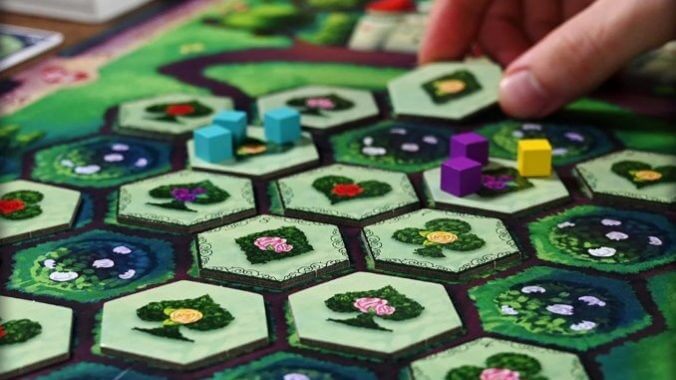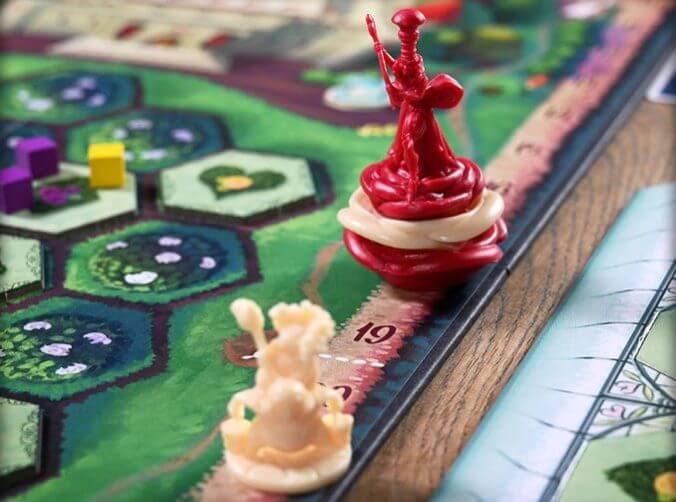Don’t Lose Your Head Playing the Surprisingly Hard Board Game Paint the Roses
Games Reviews board games
Paint the Roses is a deduction-based cooperative game with an Alice in Wonderland theme, but this is definitely no kids’ game—it’s surprisingly hard, even with the simplest rules in the base game.
In Paint the Roses, two to five players work together to try to fill the garden with flower tiles. At the same time they’re trying to deduce other players’ secret Whim cards, so that they can advance their token around the numbered track on the outside of the board. On a player’s turn, they choose one tile from the four on display and place it on the board, and then they choose which players’ Whim card the other players need to guess. If the players fill the garden before the Queen token catches up with the players’ token, they win, but the Queen gets to move after every player’s turn, speeding up as the game goes along, and moves twice as fast if the players guess incorrectly at any point.
Each tile has a flower in one of four colors and a plant shaped like one of the four suits from a deck of playing cards. The Whim cards relate to adjacent pairs of tiles on the board, and come in three levels of difficulty: Easy cards can only be color to color, medium can be color/color or shape/shape, and hard can be color/color, shape/shape, or color/shape. When you place a tile, all players put cubes of their color on that tile indicating how many adjacent tiles match their Whim card along with the new tile. So if you have a card that shows a pink flower and a purple flower, and then you place a pink flower tile that’s next to two purple flower tiles already on the board, you’d put two of your cubes on it. These cubes become clues so that others can deduce what’s on your card, or at least narrow it down to two or three possibilities.
If the players guess correctly, the players’ token moves forward the number of spots shown on that Whim card, from one for an Easy card to up to five for some Hard cards. The players can even guess multiple Whim cards in one turn. At the end of their turn, the Queen moves forward, just one space at the start of the game, with that number increasing as the players pass certain thresholds on the scoring track. If the players guessed any card incorrectly, the Queen moves twice as many spaces. The Queen does start behind the players, but it’s easy for her to catch up if you guess incorrectly a couple of times, so you don’t have much margin for error. That mechanic is new to me within cooperative games—so many use the Pandemic-style condition of a threat that increases in intensity as certain cards appear in the deck, but in this case, the Queen is chasing you around a track, and you can plan ahead to some degree to at least keep her from speeding up.

This game is winnable, but it’s hard, and it’s very well calibrated to provide a challenging experience play after play. You can get a few cards wrong, but not many, and incorrect guesses later in the game can be fatal because the Queen might be moving three to four spaces per turn anyway. There’s some strategy involved in where you place your tiles, and holding back on some cards you know so that you can string together a bunch of turns with no incorrect guesses, so there are ways to do better. There’s enough randomness, though, that even the best players will still find themselves losing on occasion, which is true even of the best cooperative games like Pandemic.
Paint the Roses might make it too easy to get stuck, however, since you are completely vulnerable to the four tiles that are on display and there’s no mechanism to refresh the supply. It’s easy to end up with several turns where you can’t get the specific color or shape of tile you need—especially in a two-player game, where you’re not cycling through tiles as quickly. It’s the rare cooperative game where it’s better to have more players, for that precise reason. More people guessing isn’t bad, but you’ll get several new tiles when it’s your turn again, and you also have more choices of cards to guess on each turn. To be clear, it’s playable with two, but it’s just much better with three or more.
The Deluxe edition of the game also includes the Escape the Castle expansion, which has five additional modules; you pick one and try to achieve a specific goal, such as matching patterns of tiles shown on the cards, five times to pass the challenge and escape the castle completely. You can also try out the base game on Board Game Arena, which also allows you to use the Cheshire Kitten promo, with the same rules as the goal card from the Escape the Castle expansion I just described.
Games take about an hour, and the listed age of 11+ seems about right—there’s a high bar in deductive reasoning required to play this game well, especially when it comes to Hard cards that require piecing together clues across multiple turns. The game even comes with a pad with the grid that would be familiar to anyone who’s played logic puzzles, so if your kid can do those puzzles, they could certainly play this game. It’s a new twist on cooperative games, and one that encourages a higher player count, too.
Keith Law is the author of The Inside Game and Smart Baseball and a senior baseball writer for The Athletic. You can find his personal blog the dish, covering games, literature, and more, at meadowparty.com/blog.